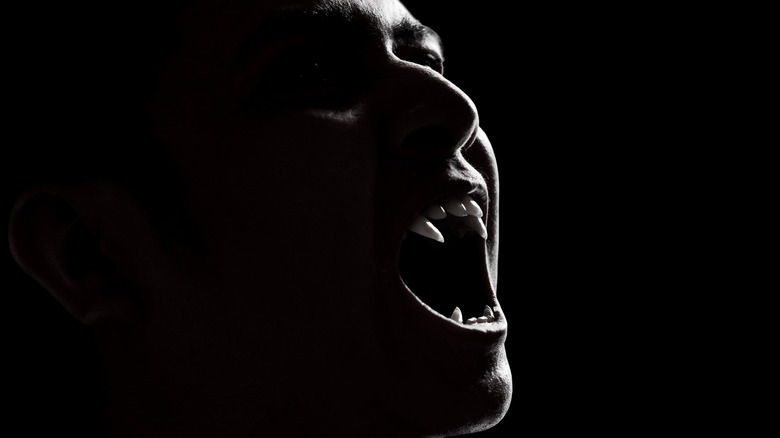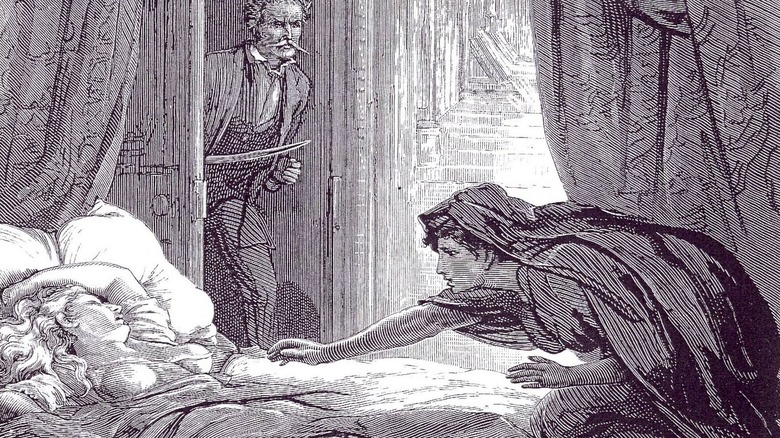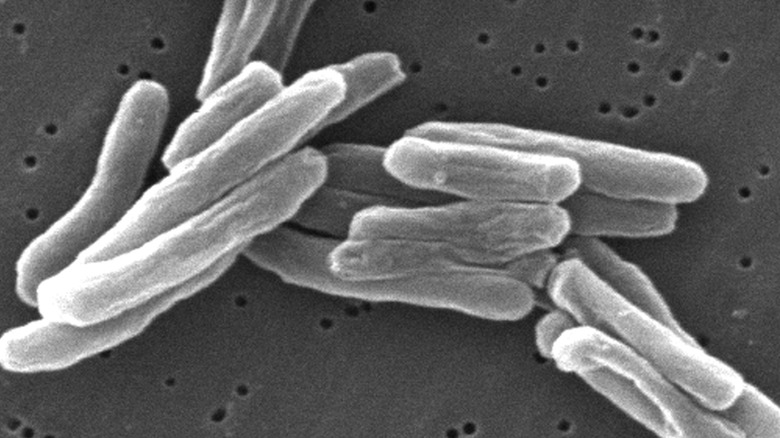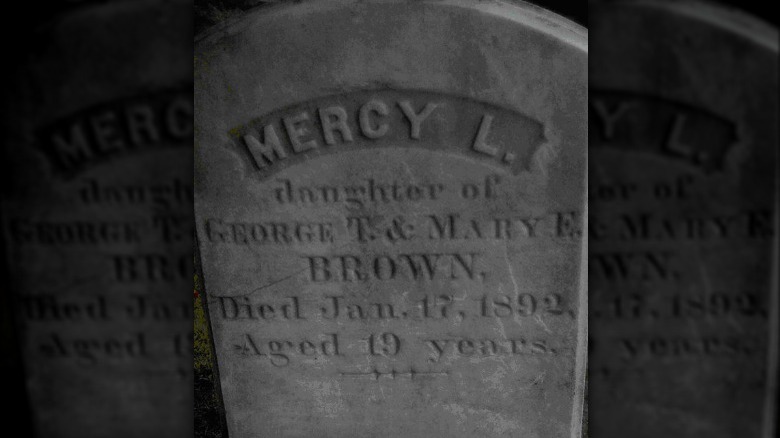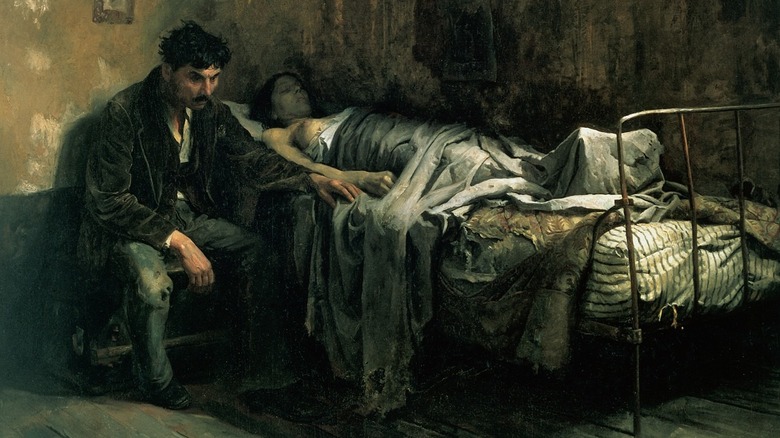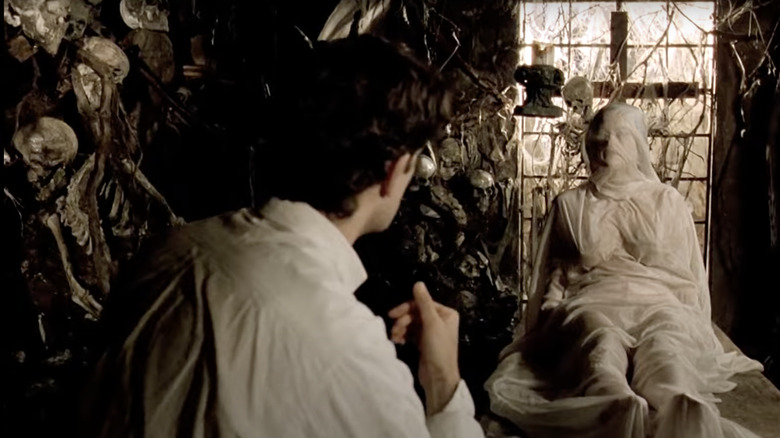What Were The Victorian Era Vampire Autopsies?
As if the Salem witch trials weren't enough, the New England countryside was terrorized by a different supernatural panic in the late 18th and through the 19th century (via Smithsonian Magazine). A lot of people don't know about the vampire terror that flourished in backwoods New England for more than 100 years. It's definitely a lesson plan that your history teacher threw out the window when there were too many snow days.
The word vampire can be traced back to 10th century Europe and was the name of a Southern Slavic folklore monster (via Meet the Slavs). Unlike the sexy vampires of today, Slavic vampires acted more like zombies — dead corpses reanimated to feed off the living. Tales of these ghouls were brought to the shores of America in the 1700s by Slavic and Germanic immigrants and spread from Maine to Pennsylvania and as far west as Minnesota.
Isolated country communities would sometimes get a funny feeling that some recently deceased and buried neighbor was coming back as a half-dead ghoul to drain the life force of the living. The only reasonable solution was to dig up the bodies of the dead and re-kill them. In reality, these created creatures were the manifestations of people's fear of death, disease, and ill fortune. And yet during the vampire exhumations and autopsies of Victorian Era New England, evidence of vampirism was always unearthed.
How New Englanders dealt with their vampires
It wasn't the fault of the dead for their deeds. They were just cold in the ground when an incorporeal evil inhabited their corpse, compelling them to visit their old haunts and warm themselves on the life force of their relatives (via Haunted Places in the World).
Each community had its own unique method to confirm and slay its specters. In Maine, you could flip a body over in its coffin, shake the cemetery dirt from your hands, and call it a night (via Smithsonian Magazine). That simply wouldn't do the trick in Rhode Island. Supposed vampires were exhumed, the rib cage opened, the heart and other organs removed and burned (via History). The smoke or ashes were then consumed by those being tormented by the dead.
Performance of vampire autopsies ranged from a hushed event of a few neighbors to town-wide spectacles. The wife of Captain Issac Burton, Rachel, got the vampire panic kicked off by getting sick and dying in 1793 Manchester, Vermont (via William G. Pomeroy Foundation). When the second wife of Captain Burton began to fall ill, the locals blamed the Captain's first. Rachel was accused of returning from the grave as a vampire to drain the life-force of her replacement. A morbid get-together popped up as hundreds attended the burning of a Rachel's vampire heart, enjoying good sleighing conditions on the way.
Tuberculosis disguised as evidence of vampirism
People were being consumed by disease, not vampires (via Atlas Obscura). The scourge truly plaguing these communities was the 15,000- to 20,000-year-old bacteria tuberculosis (via "A History of Vampires in New England" by Thomas D'Agostino). Popularly called consumption, in the 1800 the eastern United States could attribute one out of four deaths to the communicable disease. In remote, rural communities, the plague of tuberculosis would lumber ominously from one family to the next, the infected becoming weak, pale, and their respiratory system in disarray.
Unfortunately, tuberculosis patients had all the markings of vampire victims. The unlucky infected would slowly lose their coloring and turn ashen as if being drained of life (via HowStuffWorks). Smatterings of blood around their shirt collars was evidence of late-night feedings by the dearly departed instead of earlier coughing fits (via Ghostvillage). These and other symptoms were interpreted according to folklore as the dead draining the energy and life of those still alive.
That's how a community plagued by tuberculosis was also suspiciously filled with vampires. The first to die were assumed to be the cause of other family members falling ill. To break the paranormal bond between victim and vampire, bodies were exhumed to confirm suspicions with an autopsy (via Smithsonian Magazine).
How to make any corpse a vampire
The most renowned exhumed corpse of an American vampire was Mercy Lena Brown. A teenager in Exeter, Rhode Island, it was the late 1800s when her already dwindling farming community suffered a tuberculosis outbreak (via Smithsonian Magazine). The disease ravaged her family, killing her mother and sister and forcing her ill brother Edwin to flee to a better climate. Mercy slowly succumbed in 1892. But when her ill brother returned home, near death's door, neighbors concluded one of the previous dead was feasting on the now-dying brother.
Corpses always displayed signs of vampirism because the normal decaying process was interpreted as evidence. An autopsy that found fresh blood in the heart proved these wicked creatures were feasting on the living. The gastric bloating caused enlarged stomachs as if they had recently fed (via Popular Mechanics). Shrinking skin made hair and nails appear to have grown longer, indicating the corpse was still alive (via History). A decaying body can make groans, pass gas, and move its limbs. And a stake through the chest can create a garish cry as gas passes over the vocal cords (via Indiana Public Media).
News of autopsies shocked the world
Medicine was in a strange middle ground by the late 1800s. The tuberculosis bacteria was discovered in 1882. Yet the popular belief was that tuberculosis was inherited and the best cure was brown sugar drinks or frequent horseback rides (via Smithsonian Magazine). The absurd exhumation of Mercy Lena Brown's body happened in the presence of a medical examiner (via Atlas Obscura). He hoped to end the outdated practice with confirmation of bacterial growth in Brown's lungs. Even after presenting his findings, Mercy Lena's heart was removed, burned on a nearby rock, and the ashes fed to Edwin. Edwin died two months later. He was buried next to his sister.
News of this event shocked the public as it traveled around the globe to non-vampire-ridden communities. When news of this autopsy reached cities, citizens balked at the "barbaric superstition" on display by their rural countrymen. To provide perspective, Mercy Lena's unearthing occurred after the car was invented a decade before (via Library of Congress). The last known exhumation occurred way too close to present day, in 1949 Pennsylvania.
News of this Rhode Island vampire autopsy reached an English stage manager named Bram Stoker, who was inspired to write "Dracula" in 1897. It defined the modern vampire trope. Perhaps the name of the main character, Lucy, is a combination of Brown's first names, Mercy and Lena.
How superstitions can run amok
So, how did superstitions compel upstanding members of society to dig up the dead? Some have pointed to the lack of organized religion (via Smithsonian Magazine). While we think of 18th and 19th century New England as puritanical, only around 10% of the rural population were churchgoers. The argument is that disorganized beliefs led to superstition and lack of spiritual oversight. However, the Salem witch trials were directly caused by religious leadership, evidence that illogical behavior is not limited to the secular.
Another explanation is that these were desperate actions in the face of mortality. Families were leaving no gravestone unturned. One might exhume a relative simply as a sign of good faith to neighbors terrified for their own families. Still another likely explanation would be the extreme cultural isolation. Promising fortunes on the frontier or in the city caused the population of rural towns to dwindle. In these insular communities fear and folklore mixed together with medical ignorance, producing absurd interpretations of biological events. These societal ingredients continue to be abundant in today's America.
Today, fake vampire teeth decorate the tombstone of Mercy Lena Brown where she lies next to the rest of her family. Archaeologists have found numerous posthumously disturbed graves across New England believed to be sites of vampire autopsies. Dense slabs of stone rest atop the re-buried graves to prevent the return of the walking dead. They also close the lid on the Victorian Era American vampire panic.
